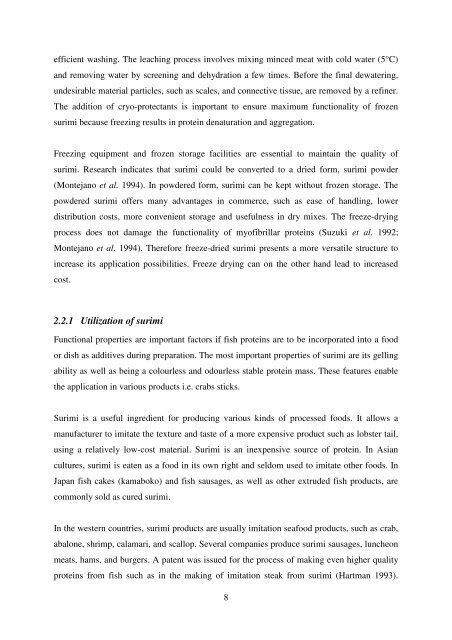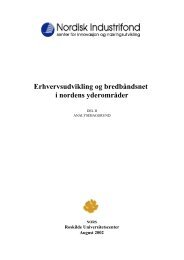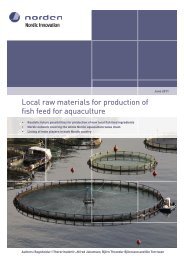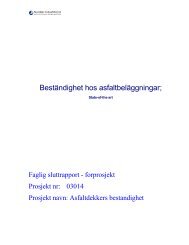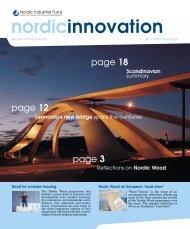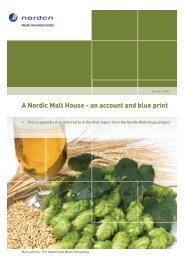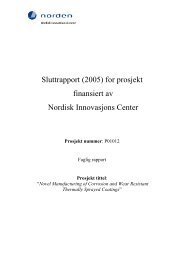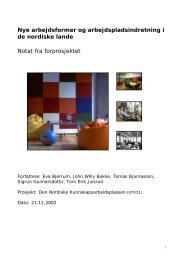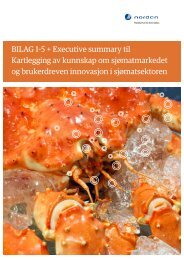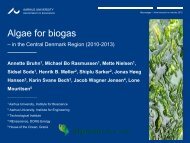Value added fish by-products - Nordic Innovation
Value added fish by-products - Nordic Innovation
Value added fish by-products - Nordic Innovation
Create successful ePaper yourself
Turn your PDF publications into a flip-book with our unique Google optimized e-Paper software.
efficient washing. The leaching process involves mixing minced meat with cold water (5°C)<br />
and removing water <strong>by</strong> screening and dehydration a few times. Before the final dewatering,<br />
undesirable material particles, such as scales, and connective tissue, are removed <strong>by</strong> a refiner.<br />
The addition of cryo-protectants is important to ensure maximum functionality of frozen<br />
surimi because freezing results in protein denaturation and aggregation.<br />
Freezing equipment and frozen storage facilities are essential to maintain the quality of<br />
surimi. Research indicates that surimi could be converted to a dried form, surimi powder<br />
(Montejano et al. 1994). In powdered form, surimi can be kept without frozen storage. The<br />
powdered surimi offers many advantages in commerce, such as ease of handling, lower<br />
distribution costs, more convenient storage and usefulness in dry mixes. The freeze-drying<br />
process does not damage the functionality of myofibrillar proteins (Suzuki et al. 1992;<br />
Montejano et al. 1994). Therefore freeze-dried surimi presents a more versatile structure to<br />
increase its application possibilities. Freeze drying can on the other hand lead to increased<br />
cost.<br />
2.2.1 Utilization of surimi<br />
Functional properties are important factors if <strong>fish</strong> proteins are to be incorporated into a food<br />
or dish as additives during preparation. The most important properties of surimi are its gelling<br />
ability as well as being a colourless and odourless stable protein mass. These features enable<br />
the application in various <strong>products</strong> i.e. crabs sticks.<br />
Surimi is a useful ingredient for producing various kinds of processed foods. It allows a<br />
manufacturer to imitate the texture and taste of a more expensive product such as lobster tail,<br />
using a relatively low-cost material. Surimi is an inexpensive source of protein. In Asian<br />
cultures, surimi is eaten as a food in its own right and seldom used to imitate other foods. In<br />
Japan <strong>fish</strong> cakes (kamaboko) and <strong>fish</strong> sausages, as well as other extruded <strong>fish</strong> <strong>products</strong>, are<br />
commonly sold as cured surimi.<br />
In the western countries, surimi <strong>products</strong> are usually imitation seafood <strong>products</strong>, such as crab,<br />
abalone, shrimp, calamari, and scallop. Several companies produce surimi sausages, luncheon<br />
meats, hams, and burgers. A patent was issued for the process of making even higher quality<br />
proteins from <strong>fish</strong> such as in the making of imitation steak from surimi (Hartman 1993).<br />
8


